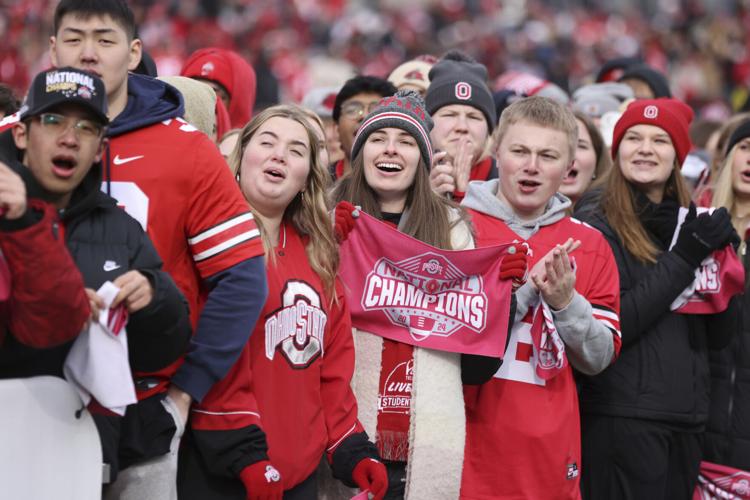Ohio State Football: A Legacy of Excellence
Ohio State University’s football program, known as the Ohio State Buckeyes, is one of the most storied and successful in the history of college football. With a rich tradition that dates back over a century, the Buckeyes have cemented their place among the elite programs in the nation. The team’s remarkable legacy of success on the field, combined with a dedicated fan base and its ability to adapt to the changing landscape of college football, has made Ohio State a powerhouse in the sport.
A Historic Beginning
The Ohio State University football program began in 1890 under the direction of head coach James Owen. While the early years were marked by modest success, the foundation for greatness was being laid. The Buckeyes achieved their first winning season in 1892, and over the next few decades, the program gradually grew in stature. The 1920s and 1930s were particularly notable for Ohio State, as the team began to assert itself as one of the premier football programs in the Midwest.
The 1930s marked a significant turning point for Ohio State football, with the hiring of head coach Francis Schmidt in 1934. Schmidt led the Buckeyes to their first Big Ten Championship in 1935, and his innovative coaching style began to set the stage for Ohio State’s dominance in the decades to follow. Schmidt’s tenure also saw the emergence of star players, including the legendary “Chic” Harley, who became a household name in the state of Ohio and beyond.
The Golden Age: Woody Hayes and the 1960s
The most significant chapter in Ohio State’s history began in 1951 with the hiring of Woody Hayes as head coach. Hayes, who would go on to become one of the most successful and influential coaches in college football history, set the standard for excellence that still resonates in the program today. His tenure at Ohio State lasted from 1951 to 1978, during which he transformed the Buckeyes into an unstoppable force in college football.
Hayes’ coaching philosophy was rooted in discipline, toughness, and a commitment to winning at all costs. Under his leadership, Ohio State became a national powerhouse, winning five national championships (1954, 1957, 1961, 1968, and 1970) and dominating the Big Ten Conference. His teams were known for their hard-nosed, physical style of play, often emphasizing the run game, which became a hallmark of Ohio State football.
One of the most iconic moments in Ohio State football history came in 1968, when the Buckeyes completed an undefeated season and won the national championship. Led by star running back and Heisman Trophy winner O.J. Simpson, the Buckeyes defeated the University of Southern California in the Rose Bowl to cap off a perfect campaign. This victory marked the pinnacle of Ohio State’s success under Hayes, and the team would continue to be a dominant force for years to come.
The Rivalry with Michigan
One of the defining characteristics of Ohio State football is its intense rivalry with the University of Michigan. The “Michigan-Ohio State rivalry,” also known as “The Game,” is one of the most storied rivalries in all of sports. For decades, these two teams have clashed in a battle for supremacy in the Big Ten and national championships. The rivalry began to take on national significance in the 1960s and 1970s, as both teams were consistently among the top programs in college football.
Woody Hayes and Michigan coach Bo Schembechler, who arrived at Michigan in 1969, played a key role in intensifying the rivalry. The two coaches’ fierce competitive spirit and contrasting styles of play fueled the drama that surrounded each annual matchup. The game became a must-watch event, with the outcome often determining the Big Ten champion and a spot in the Rose Bowl or national championship race.
The rivalry reached its zenith in 2006 when the two teams, both undefeated, faced off in one of the most anticipated games in college football history. Ohio State, led by quarterback Troy Smith, defeated Michigan 42-39 in a thrilling contest that was dubbed the “Game of the Century.” This game solidified the rivalry’s place in the pantheon of college football, and it remains one of the most memorable moments in Ohio State’s storied history.
Transition and Continued Success: The 1980s and 1990s
After Woody Hayes’ departure in 1978, Ohio State football underwent a period of transition. The program experienced both success and frustration during this era, as the Buckeyes were led by a series of head coaches, including Earle Bruce and John Cooper. While the team remained competitive in the Big Ten, the national championship eluded them during this period.
Under Earle Bruce, who succeeded Hayes in 1979, Ohio State won a Big Ten championship and made several appearances in major bowl games. Bruce’s tenure is particularly remembered for his success against Michigan, as he led the Buckeyes to several victories over their rivals during his time as head coach. However, Bruce was unable to capture a national championship, and after a disappointing season in 1987, he was replaced by John Cooper in 1988.
Cooper’s era at Ohio State was marked by consistent success, but also by an inability to win key games, particularly against Michigan. Under Cooper, the Buckeyes won several Big Ten titles and earned a spot in the Rose Bowl, but they fell short of a national championship. Despite this, Cooper’s tenure helped establish Ohio State as a perennial contender on the national stage, setting the stage for future success.
The Jim Tressel Era
The arrival of Jim Tressel in 2001 marked a new chapter in Ohio State football. Tressel’s coaching philosophy was a blend of discipline, leadership, and the power of teamwork. He quickly became a beloved figure in Ohio, and his teams enjoyed tremendous success. Tressel’s ability to recruit elite talent, combined with his emphasis on fundamentals and preparation, helped elevate Ohio State to new heights.
In just his second season as head coach, Tressel led the Buckeyes to the 2002 national championship, one of the most unforgettable seasons in school history. Ohio State’s thrilling victory over the University of Miami in the BCS National Championship Game, which went into overtime, was a testament to Tressel’s ability to motivate his players and lead them through adversity. Quarterback Craig Krenzel and defensive standout Chris Gamble were key contributors to the victory, and the team’s defensive unit, led by coach Mark Dantonio, was the cornerstone of their championship success.
Tressel would go on to win a second national championship in 2006 when Ohio State earned a spot in the national title game against Florida. Unfortunately, the Buckeyes were defeated by the Gators, but Tressel’s legacy at Ohio State was firmly established. His teams were consistently among the nation’s best, and he helped solidify Ohio State’s position as a dominant force in college football.
Urban Meyer and the Modern Era
Urban Meyer’s arrival at Ohio State in 2012 marked another turning point for the program. Meyer, who had previously won national championships at the University of Florida, brought a new level of energy and excitement to Ohio State football. Under Meyer’s leadership, the Buckeyes achieved unprecedented success, including an undefeated season in 2012, his first year as head coach.
In 2014, Meyer guided Ohio State to its eighth national championship, completing a remarkable season that saw the Buckeyes overcome numerous challenges. Despite losing starting quarterback Braxton Miller to injury before the season, backup quarterback Cardale Jones led the team to a thrilling victory in the College Football Playoff, defeating Oregon in the national championship game. The win capped off a magical season for Ohio State, and it solidified Meyer’s legacy as one of the most successful coaches in college football history.
Meyer’s tenure at Ohio State was marked by sustained success, with the Buckeyes winning multiple Big Ten championships and making regular appearances in the College Football Playoff. Meyer’s ability to recruit elite talent, his offensive innovations, and his emphasis on building a strong defensive unit made Ohio State one of the most dangerous teams in the nation.
Ryan Day and the Future
Following Urban Meyer’s retirement in 2019, Ryan Day took over as head coach of Ohio State. Day, a former offensive coordinator under Meyer, has continued the program’s tradition of excellence. In his first season as head coach, Day led Ohio State to a perfect 13-0 record and a spot in the College Football Playoff, where they fell just short of a national championship.
Day has proven to be an excellent recruiter and developer of talent, particularly on the offensive side of the ball. Under his leadership, the Buckeyes have continued to dominate the Big Ten and remain a perennial contender for the national title. Day’s emphasis on high-powered offenses, with standout players like quarterback Justin Fields, running back J.K. Dobbins, and wide receiver Garrett Wilson, has made Ohio State one of the most dangerous teams in college football.
The future of Ohio State football looks bright under Ryan Day, with a continued commitment to excellence both on and off the field. The program’s deep roster of talented players, combined with Day’s leadership, promises that Ohio State will remain a force in college football for years to come.
The Legacy
Ohio State football’s legacy is defined by its tradition of excellence, its passionate fan base, and its commitment to developing not only great players but also great men. The program has produced countless NFL players, Heisman Trophy winners, and national champions, and its impact on the sport of college football is immeasurable. From Woody Hayes to Urban Meyer to Ryan Day, the Buckeyes have been led by visionary coaches who have shaped the history of the sport.
Ohio State’s success is also a testament to the enduring passion of its fans. The “Buckeye Nation” is one of the most loyal and dedicated fan bases in all of college sports. Whether tailgating in the parking lots surrounding the iconic Ohio Stadium, or cheering from the stands inside the “Horseshoe,” the energy and enthusiasm of Ohio State fans are unmatched.
As the Buckeyes continue to build on their storied legacy, one thing is certain: Ohio State football will remain a symbol of excellence, pride, and tradition for generations to come.



